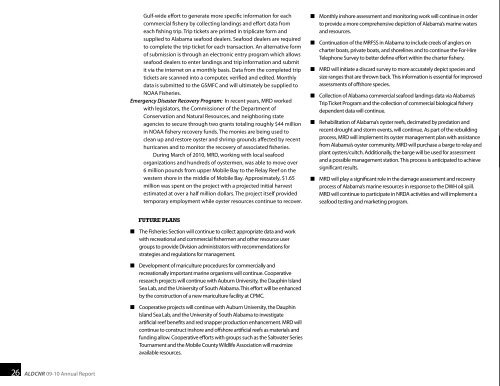2009-2010 Annual Report - Alabama Department of Conservation ...
2009-2010 Annual Report - Alabama Department of Conservation ...
2009-2010 Annual Report - Alabama Department of Conservation ...
You also want an ePaper? Increase the reach of your titles
YUMPU automatically turns print PDFs into web optimized ePapers that Google loves.
Gulf-wide effort to generate more specific information for each<br />
commercial fishery by collecting landings and effort data from<br />
each fishing trip. Trip tickets are printed in triplicate form and<br />
supplied to <strong>Alabama</strong> seafood dealers. Seafood dealers are required<br />
to complete the trip ticket for each transaction. An alternative form<br />
<strong>of</strong> submission is through an electronic entry program which allows<br />
seafood dealers to enter landings and trip information and submit<br />
it via the internet on a monthly basis. Data from the completed trip<br />
tickets are scanned into a computer, verified and edited. Monthly<br />
data is submitted to the GSMFC and will ultimately be supplied to<br />
NOAA Fisheries.<br />
Emergency Disaster Recovery Program: In recent years, MRD worked<br />
with legislators, the Commissioner <strong>of</strong> the <strong>Department</strong> <strong>of</strong><br />
<strong>Conservation</strong> and Natural Resources, and neighboring state<br />
agencies to secure through two grants totaling roughly $44 million<br />
in NOAA fishery recovery funds. The monies are being used to<br />
clean up and restore oyster and shrimp grounds affected by recent<br />
hurricanes and to monitor the recovery <strong>of</strong> associated fisheries.<br />
During March <strong>of</strong> <strong>2010</strong>, MRD, working with local seafood<br />
organizations and hundreds <strong>of</strong> oystermen, was able to move over<br />
6 million pounds from upper Mobile Bay to the Relay Reef on the<br />
western shore in the middle <strong>of</strong> Mobile Bay. Approximately, $1.65<br />
million was spent on the project with a projected initial harvest<br />
estimated at over a half million dollars. The project itself provided<br />
temporary employment while oyster resources continue to recover.<br />
n Monthly inshore assessment and monitoring work will continue in order<br />
to provide a more comprehensive depiction <strong>of</strong> <strong>Alabama</strong>’s marine waters<br />
and resources.<br />
n Continuation <strong>of</strong> the MRFSS in <strong>Alabama</strong> to include creels <strong>of</strong> anglers on<br />
charter boats, private boats, and shorelines and to continue the For-Hire<br />
Telephone Survey to better define effort within the charter fishery.<br />
n MRD will initiate a discard survey to more accurately depict species and<br />
size ranges that are thrown back. This information is essential for improved<br />
assessments <strong>of</strong> <strong>of</strong>fshore species.<br />
n Collection <strong>of</strong> <strong>Alabama</strong> commercial seafood landings data via <strong>Alabama</strong>’s<br />
Trip Ticket Program and the collection <strong>of</strong> commercial biological fishery<br />
dependent data will continue.<br />
n Rehabilitation <strong>of</strong> <strong>Alabama</strong>’s oyster reefs, decimated by predation and<br />
recent drought and storm events, will continue. As part <strong>of</strong> the rebuilding<br />
process, MRD will implement its oyster management plan with assistance<br />
from <strong>Alabama</strong>’s oyster community. MRD will purchase a barge to relay and<br />
plant oysters/cultch. Additionally, the barge will be used for assessment<br />
and a possible management station. This process is anticipated to achieve<br />
significant results.<br />
n MRD will play a significant role in the damage assessment and recovery<br />
process <strong>of</strong> <strong>Alabama</strong>’s marine resources in response to the DWH oil spill.<br />
MRD will continue to participate in NRDA activities and will implement a<br />
seafood testing and marketing program.<br />
Future Plans<br />
n The Fisheries Section will continue to collect appropriate data and work<br />
with recreational and commercial fishermen and other resource user<br />
groups to provide Division administrators with recommendations for<br />
strategies and regulations for management.<br />
n Development <strong>of</strong> mariculture procedures for commercially and<br />
recreationally important marine organisms will continue. Cooperative<br />
research projects will continue with Auburn University, the Dauphin Island<br />
Sea Lab, and the University <strong>of</strong> South <strong>Alabama</strong>. This effort will be enhanced<br />
by the construction <strong>of</strong> a new mariculture facility at CPMC.<br />
n Cooperative projects will continue with Auburn University, the Dauphin<br />
Island Sea Lab, and the University <strong>of</strong> South <strong>Alabama</strong> to investigate<br />
artificial reef benefits and red snapper production enhancement. MRD will<br />
continue to construct inshore and <strong>of</strong>fshore artificial reefs as materials and<br />
funding allow. Cooperative efforts with groups such as the Saltwater Series<br />
Tournament and the Mobile County Wildlife Association will maximize<br />
available resources.<br />
26<br />
ALDCNR 09-10 <strong>Annual</strong> <strong>Report</strong>
















